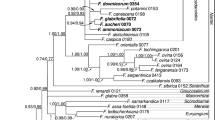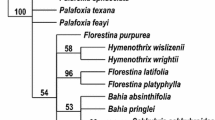Abstract
Species delimitation in the genus Geopora (Pyronemataceae) is complicated because of small number of differentiating characters, values of which tend to overlap among the species. Current classification relies mainly on size and shape of ascospores and fruit-bodies, position of the apothecia in the ground and length of excipular hairs. We measured ascospores in ca. 90 Geopora specimens. Sequences of internal transcribed spacer (ITS) rDNA gene were obtained to investigate phylogenetic relationships in the genus. Maximum parsimony (MP) and Bayesian analyses reveal that the well-supported clades detected often do not correspond to the species concepts based on morphological characters. Nine out of the ten lineages include specimens which were initially identified as belonging to different species. The dimensions of ascospores vary to great extent within the lineages. The size and shape of fruit-bodies, length of excipular hair and hymenium colour are mostly homogenous within each clade; however, these characters coincide to a great extent among the lineages and the latter can be assessed only from fresh fruit-bodies. Nuclear DNA content, and accordingly, ploidy level do not provide evidence for species distinction. Geopora arenicola, G. tenuis and G. sepulta were recognized as monophyletic species. Geopora foliacea and G. cervina could not be explicitly delimited and the G. cervina complex comprising three clades was introduced.


Similar content being viewed by others
References
Ahmad S (1978) Ascomycetes of Pakistan. Part 1. Biological Society of Pakistan, Lahore. Monograph No. 7
Bidartondo MI, Baar J, Bruns TD (2001) Low ectomycorrhizal inoculum potential anddiversity from soils in and near ancient forests of bristlecone pine (Pinus longaeva). Can J Bot 79:293–299. doi:10.1139/cjb-79-3-293
Bidartondo MI, Burghardt B, Gebauer G, Bruns TD, Read DJ (2004) Changing partners in the dark: isotopic and molecular evidence of ectomycorrhizal liaisons between forest orchids and trees. Proc R Soc Lond B 271:1799–1806. doi:10.1098/rspb.2004.2807
Bois G, Piché Y, Fung MYP, Khasa DP (2005) Mycorrhizal inoculum potentials of pure reclamation materials and revegetated tailing sands from the Canadian oil sand industry. Mycorrhiza 15:149–158. doi:10.1007/s00572-004-0315-4
Burdsall HH Jr (1965) Operculate asci and puffing of ascospores in Geopora (Tuberales). Mycologia 57:485–487
Burdsall HH Jr (1968) A revision of the genus Hydnocystis (Tuberales) and of the hypogeous species of Geopora (Pezizales). Mycologia 60:496–525
Cooke MC (1876) Mycographia, seu icones fungorum, 1:45–86. Williams & Norgate, London
Dennis RWG (1968) British ascomycetes, 2nd edn. Cramer, London
Dissing H (2000) Pezizales. In: Hansen L, Knudsen H (eds) Nordic Macromycetes 1:55–128. Nordsvamp, Copenhagen
El Karkouri K, Martin F, Mousain D (2004) Diversity of ectomycorrhizal symbionts in a disturbed Pinus halepensis plantation in the Mediterranean region. Ann For Sci 61:705–710
Fries EM (1851) Novarum Symbolarum Mycologicarum Mantissa. Acta Reg Soc Sci Upps Ser 3. 1:225–231
Fuckel L (1866) Fungi Rhenani exsiccati. Cent. 12–17, No. 1101–1700. Hedwigia 5:14–16
Fujimura KE, Smith JE, Horton TR, Weber NS, Spatafora JW (2005) Pezizalean mycorrhizas and sporocarps in ponderosa pine (Pinus ponderosa) after prescribed fires in eastern Oregon, USA. Mycorrhiza 15:79–86
Gardes M, Bruns TD (1993) ITS primers with enhanced specificity for basidiomycetes—application to the identification of mycorrhizae and rusts. Mol Ecol 2:113–118
Gehring CA, Theimer TC, Whitham TG, Keim P (1998) Ectomycorrhizal fungal community structure of pinyon pines growing in two environmental extremes. Ecology 79:1562–1572
Hansen K, Pfister DH, Hibbett DS (1999) Phylogenetic relationships among species of Phillipsia inferred from molecular and morphological data. Mycologia 91:299–314
Hansen K, Læssøe T, Pfister DH (2002) Phylogenetic diversity in the core group of Peziza inferred from ITS sequences and morphology. Mycol Res 106:879–902
Harkness HW (1885) Fungi of the Pacific Coast. Bull Calif Acad Sci 1:159–176
Huelsenbeck JP, Ronquist F (2001) MRBAYES: Bayesian inference of phylogeny. Bioinformatics 17:754–755
Kaldorf M, Renker C, Fladung M, Buscot F (2004) Characterization and spatial distribution of ectomycorrhizas colonizing aspen clones released in an experimental field. Mycorrhiza 14:295–306. doi:10.1007/s00572-003-0266-1
Katoh K, Misawa K, Kuma K, Miyata T (2002) MAFFT: a novel method for rapid multiple sequence alignment based on fast Fourier transform. Nucleic Acids Res 30:3059–3066
Kers LE (1974) The Swedish Geoporae and their pyrenomycete infections. Svensk Bot Tidskr 68:344–354
Kullman B (1998) Two sibling species of the genus Byssonectria (Pezizales). Suppression of spore development under environmental stress. Mycotaxon 69:199–207
Kullman B (2002) Nuclear DNA content, life cycle and ploidy in two Neottiella species (Pezizales, Ascomycetes). Persoonia 18:103–115
Kullman B, Teterin W (2006) Estimation of fungal genome size: comparison of image cytometry and photometric cytometry. Folia Cryptogam Est 42:43–56
Læssøe T, Hansen K (2007) Truffle trouble: what happened to the Tuberales? Mycol Res 111:1075–1099
Lumbsch HT, Huhndorf SM (eds) (2007) Outline of Ascomycota-2007. Myconet 13:1–58
Maia LC, Yano AM, Kimbrough JW (1996) Species of Ascomycota forming ectomycorrhizae. Mycotaxon 57:371–390
Massee G (1895) British fungus flora. A classified text-book of mycology, vol 4. George Bell, London
Mueller RC, Gehring CA (2006) Interactions between an above-ground plant parasite and below-ground ectomycorrhizal fungal communities on pinyon pine. J Ecol 94:276–284
Nannfeldt JA (1941) Sepultaria arenicola (Lév.) Massee. In: Lundell S, Nannfeldt JA (Eds) Fungi exsiccati Suecici, praesertim Upsaliensis No. 958. Uppsala
Nara K, Nakaya H, Wu B, Zhou Z, Hogetsu T (2003) Underground primary succession of ectomycorrhizal fungi in a volcanic desert on Mount Fuji. New Phytol 159:743–756
Nylander JAA (2004) MRMODELTEST 2.2. Evolutionary Biology Centre, Uppsala University, Uppsala
Parádi I, Baar J (2006) Mycorrhizal fungal diversity in willow forests of different age along the river Waal, The Netherlands. For Ecol Manag 237:366–372. doi:10.1016/j.foreco.2006.09.059
Perry BA, Hansen K, Pfister DH (2007) A phylogenetic overview of the family Pyronemataceae (Ascomycota, Pezizales). Mycol Res 111:549–571
Phillips W (1887) A manual of the British discomycetes. Kegan Paul, Trench, London
Rambaut A (1996) Se-Al: Sequence Alignment Editor http://evolve.zoo.ox.ac.uk
Rincón A, De Felipe MR, Fernández-Pascual M (2007) Inoculation of Pinus halepensis Mill. with selected ectomycorrhizal fungi improves seedling establishment 2 years after planting in a degraded gypsum soil. Mycorrhiza 18:23–32
Ronquist F, Huelsenbeck JP (2003) MRBAYES 3: Bayesian phylogenetic inference under mixed models. Bioinformatics 19:1572–1574
Schumacher T (1979) Notes on taxonomy, ecology, and distribution of operculate discomycetes (Pezizales) from river banks in Norway. Norw J Bot 26:53–83
Seaver FJ (1928) The North American cup-fungi (Operculates). Seaver, New York
Selosse MA, Faccio A, Scappaticci G, Bonfante P (2004) Chlorophyllous and achlorophyllous specimens of Epipactis microphylla (Neottieae, Orchidaceae) are associated with ectomycorrhizal septomycetes, including truffles. Microb Ecol 47:416–426. doi:10.1007/s00248-003-2034-3
Shefferson RP, Kull T, Tali K (2008) Mycorrhizal interactions of orchids colonizing Estonian mine tailings hills. Am J Bot 95:156–164
Smith ME, Douhan GW, Rizzo DM (2007) Ectomycorrhizal community structure in a xeric Quercus woodland based on rDNA sequence analysis of sporocarps and pooled roots. New Phytol 174:847–863
Swofford DL (2003) PAUP*. Phylogenetic analysis using parsimony (*and other methods) Version 4.0b10. Sinauer, Sunderland
Tedersoo L, Kõljalg U, Hallenberg N, Larsson KH (2003) Fine scale distribution of ectomycorrhizal fungi and roots across substrate layers including coarse woody debris in a mixed forest. New Phytol 159:153–165
Tedersoo L, Hansen K, Perry BA, Kjøller R (2006) Molecular and morphological diversity of pezizalean ectomycorrhiza. New Phytol 170:581–596
Yao YJ, Spooner BM (1996a) Notes on British species of Geopora. Mycol Res 100:72–74
Yao YJ, Spooner BM (1996b) Geopora sepulta (Pezizales) in Britain, with a key to British species of the genus. Kew Bull 51:381–383
Yao YJ, Spooner BM (2003) The occurrence of Geopora arenosa in the British Isles. Kew Bull 58:247–252
Ypsilos IK, Magan N (2005) Characterisation of optimum cultural environmental conditions for the production of high numbers of Metarhizium anisopliae blastospores with enhanced ecological fitness. Biocontrol Sci Technol 15:683–699
Acknowledgements
We thank T. Tammaru for helping with statistical analyses. This study was supported by Estonian Science Foundation (grants 4989 and 6939), Doctoral School of Ecology and Environmental Sciences, the Estonian Ministry of Education and Science (target-financing project 0180012s09) and the European Regional Development Fund (Centre of Excellence FIBIR).
Author information
Authors and Affiliations
Corresponding author
Rights and permissions
About this article
Cite this article
Tamm, H., Põldmaa, K. & Kullman, B. Phylogenetic relationships in genus Geopora (Pyronemataceae, Pezizales). Mycol Progress 9, 509–522 (2010). https://doi.org/10.1007/s11557-010-0659-4
Received:
Revised:
Accepted:
Published:
Issue Date:
DOI: https://doi.org/10.1007/s11557-010-0659-4




